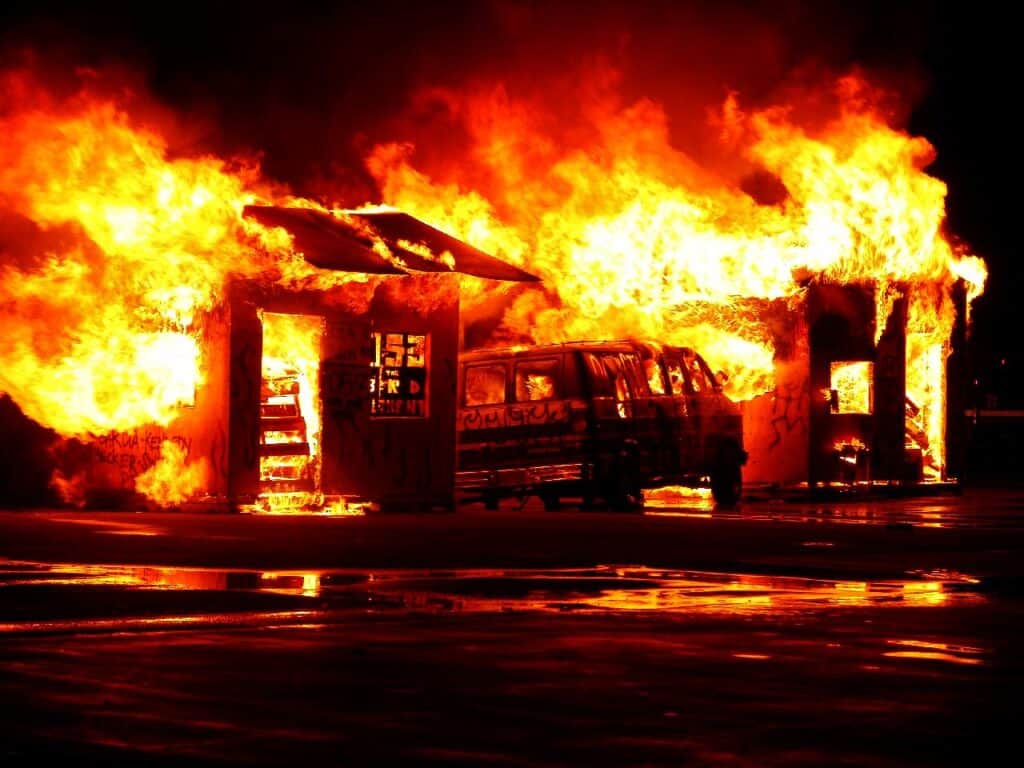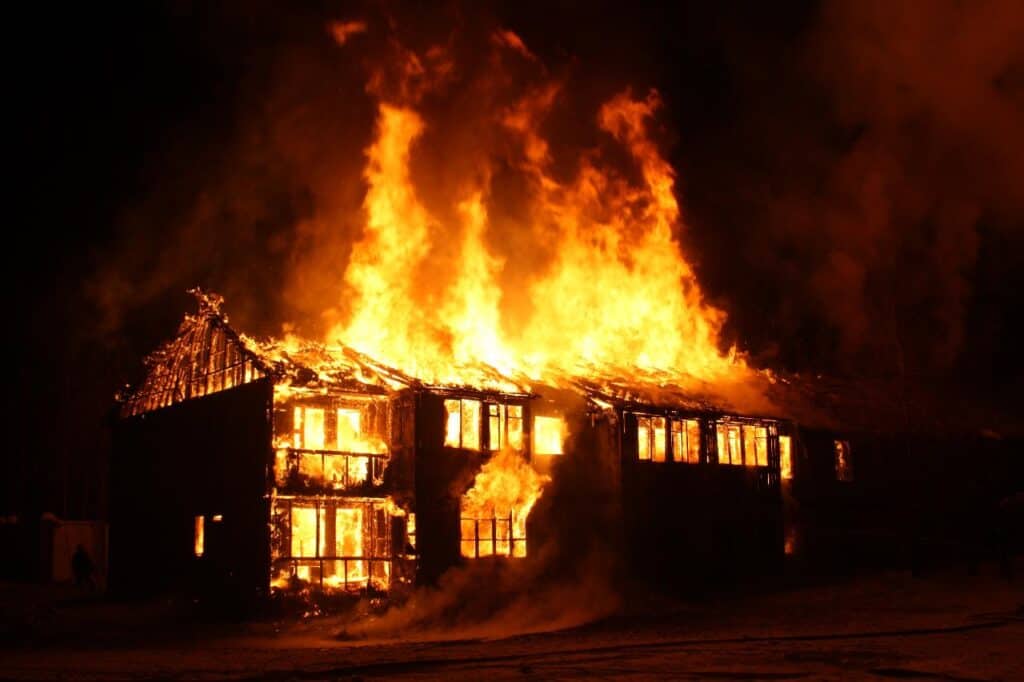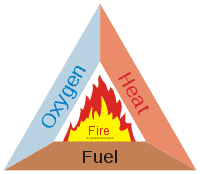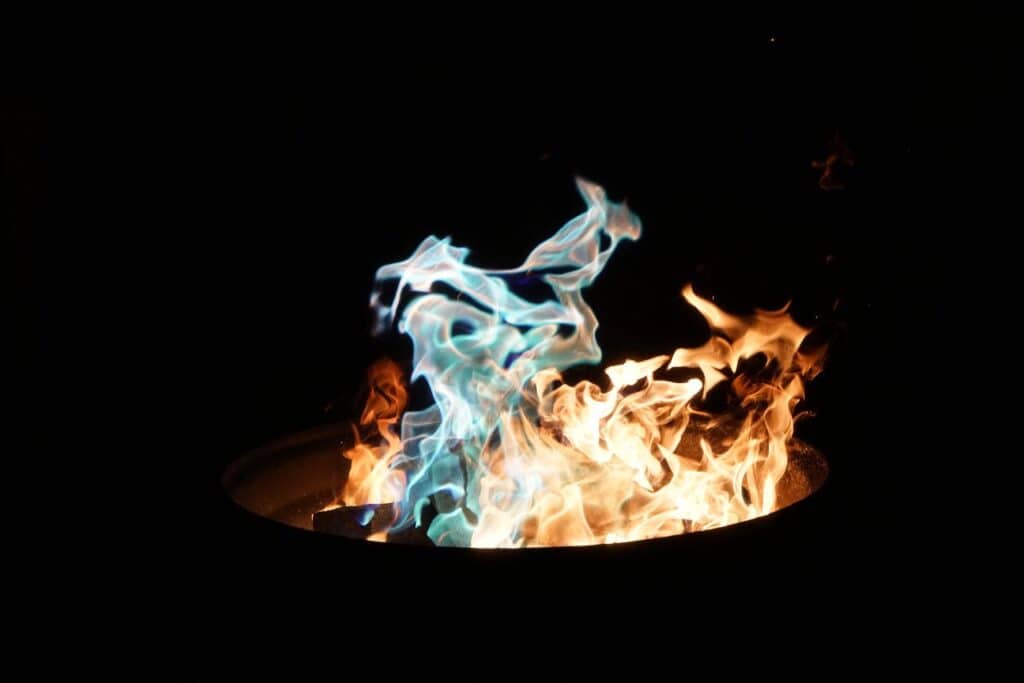To Make a Fire Alive Again
As an Amazon Associate, I earn from qualifying purchases (at no added cost to you).
Humanity's dominance of the Earth comes, in large part, due to the ability to control fire. We can use fire to bring forth metals and other materials which allow us to construct complex tools and habitats for our own use. But have you ever noticed that fire often seems to be alive? Is it possible that by using fire we've enslaved a living being for our own purposes?
According to biologists, fire is not alive. Fire does share many similarities with living things, in that it needs oxygen and fuel, and it grows, moves, and spreads. However, it does not fit all the biological criteria of life.
I've been digging into the life cycle of fire to see just how deep these similarities go. Here's what you need to know about fire.
Your # 1 priority is keeping your family safe. As a firefighter, I recommend everyone has updated smoke detectors that don't require battery changes, like these ones from Kidde , a fire extinguisher, like this one from Amerex , and a fire escape ladder if you have bedrooms above the first floor, I recommend this one from Hausse.
Also read: What Is The Temperature Of Fire? How Hot Does it Get?
Table of Contents
- Is Fire Alive?
- What Are The Official Characteristics of Life?
- How Do The Characteristics of Life Apply to Fire?
- Is Flammability a Physical or Chemical Property?
- What Is a Physical Property?
- What Is a Chemical Property?
- What Is Flammability?
- Stages of Fire
- The 4 Stages of Fire
- The 5 Stages Of Fire
- How Does Fire Spread? (Heat Transfer)
- How Do You Extinguish ("Kill") a Fire?
- Does Fire Need Oxygen?
- Fire vs Flame: What's The Difference?
- Can Fire Be Cold?
- Can Fire Be Frozen?
- What Does The Idea of "Cold Fire" Mean?
- Why Is Fire Hot?
- Hottest Fire Color
- Does Fire Have a Shadow?
- Why Is Fire Orange/Red?
- Sources
- Related Articles
Is Fire Alive?

Fire certainly appears to be alive when you first observe it.
You can see it come into being, move around, even dance, it spreads and infects other things and it requires oxygen as though it were drawing breath as we do.
And, eventually, just as we do, fire must draw to an end, "die" if you will.
And this explains why poets and storytellers often use fire as a metaphor for life and say things like, "there was a raging fire in his heart, that could not be put out."
But unfortunately, while we love poetry and literature as much as the next person, these things are not the criteria for life.
Those criteria have been defined by biologists.
Let's take a look at them and then see how fire matches up to them and determine for ourselves if fire is truly alive.
Also read: Symbolism of Fire: Spiritual, Dreams, History
What Are The Official Characteristics of Life?
All forms of life, according to biologists, share certain similar characteristics and these are:
- Order – that means they are made out of separate parts that function in an ordered fashion when put together. So, for example, cells form tissues which form organs and then organs form systems.
- Response to stimuli – this can also be termed "sensitivity". So, for example, a plant will bend towards the source of sunlight it receives and a bacterial cell might flinch from certain chemicals.
- Reproduction – all living things reproduce, because without progeny there is no evolution and there is no survival.
- Growth and development – all living things are "encoded" in their DNA to grow and develop in a specific fashion. This is why, at some point in their life cycle, offspring tend to resemble (to some extent) their parents.
- Regulation – living things have systems that allow them to regulate their responses to the environment and other pressures. Think of our blood supplying oxygen as needed and removing waste materials from around the body.
- Homeostasis – the ability to maintain a "steady state", such as the ability of the human body to maintain our internal temperature in a steady range
- Energy processing – the use of energy to drive the processes that the organism needs to live and thrive
Also read: Does Fire Kill Germs/Bacteria/Viruses?
How Do The Characteristics of Life Apply to Fire?
Now, to determine if fire is really alive, we have a framework to measure it against, so let's see how it does:
- Order – fire is made out of separate parts, but there's no "ordered fashion" to things, in fact, fire is incredibly unpredictable
- Response to stimuli – fire does not respond to stimuli, it may be extinguished by water, but it doesn't know to avoid the spray of water from a fire extinguisher or a hose
- Reproduction – you could argue that fire reproduces, because it can set other things on fire, but that's not the same as producing versions of itself, an oil fire, for example, is not the same as a house fire even if they are both lit by the same source of fire
- Growth and development – fires certainly grow, assuming there's enough oxygen and fuel around for them to do so, but it's not a form of "development" and there's no underlying instruction set (like DNA) to make it happen
- Regulation – there are also no systems of regulation within a fire, though you might be able to argue that chemical bonds act as "regulation", in terms of what burns and how it burns
- Homeostasis – there is no system in fire to maintain homeostasis at all, fires burn when they have fuel and oxygen and they stop when these things are taken away, but this isn't achieved through a regulatory system as it is with life, it's a constraint of availability
- Energy processing – well, this is one thing fires do have in life, they take energy and they expend that energy (in heat, light and sound)
So, there you have it.
Fire is not alive because it doesn't have the essential characteristics of life as defined by biologists.
This is probably a good thing because living things tend to evolve.
Can you imagine how much harder it would be to deal with fire if it evolved to be intelligent and avoid our efforts to extinguish it?
This video goes more into the details and science of fire:
Is Flammability a Physical or Chemical Property?
So, if fire is not alive, what is it?
Well, for that, we can turn to the sciences and this time, we leave biology, the science of life, behind and ask is fire physical or chemical or is it, perhaps, both?
Also read: Burning vs. Melting: What's The Difference?
So, let's begin with some definitions:
What Is a Physical Property?
A physical property is a property of matter that does not associate with changes in chemical composition.
So for, example, a carbon atom retains the same density whether it is in pure carbon or in solid carbon compounds, it has the same color too, carbon remains equally hard in all forms, it has the same melting and boiling points, and conducts electricity in the same fashion too.
Physical properties will change, to some extent, during phase changes. So, ice, for example, has a different set of physical properties when compared to water than when compared to steam.
This also means that physical changes are often easy to observe, we all see wax melt or sugar dissolving in coffee.
What Is a Chemical Property?
A chemical property, on the other hand, is a change from one type of matter into another.
When Nitrogen bonds with Hydrogen to form Ammonia would be a chemical change.
When Hydrogen bonds with Oxygen to form Water that too would be a chemical change.
There are many different chemical properties such as toxicity, acidity, reactivity, and, indeed, flammability.
This is because fire is the result of a chemical reaction.
When you burn something, you are changing its chemical state – by "oxidizing" it (that is reacting the substance with oxygen) and the process releases heat, light, and sound.
Also read: Is Flammability A Chemical Or Physical Property?
What Is Flammability?
It's, perhaps, worth noting at this point that flammability is the chemical property that measures how easy it is to burn something.
So, for example, a massive block of titanium will not burn easily, and it is considered not-flammable or non-flammable (annoyingly, "inflammable" means the same thing as "flammable" and does not follow the usual English rule of using "in" before a word to mean the opposite).
A glass of methanol, on the other hand, will burn very easily, indeed. It takes only the slightest spark or hint of flame at room temperature to see methanol become a raging blaze. Thus methanol is highly flammable.
Also read: What Makes Something Flammable?
Stages of Fire
Even if fire is not "alive" in the biological sense, does it have stages between the start of a fire and the end of a fire and, if so, can we identify those stages and, perhaps, make use of them in fighting or, at least, understanding fires.
The answer is, of course, yes, we can.
There are two main stage models of fire and they build on each other rather than existing in separate fields of study and each of them can be useful to you.
Also read: How Fast Does Fire Spread? (House Fire, Wildfire)
The 4 Stages of Fire

The most basic model of fire has four stages:
- Ignition. A fire ignites when there are three things present: oxygen, a fuel (or fuels) and enough heat to make a chemical reaction begin between the fuel(s) and the oxygen. This might be a small amount of heat (as with methanol fires) or very large amounts of heat (as with Titanium fires). Without any of these three components, you cannot start a fire.
- Growth. The growth phase of a fire takes place after ignition as the fire ignites any further fuel sources and spreads to cover the available fuel.
- Fully developed. At this stage further growth is not possible, the fuel is fully enveloped in fire and the temperature should be at its peak. A fire at this stage requires a lot of oxygen.
- Decay (burnout). Eventually a fire either runs out of fuel or it runs out of oxygen or heat. Any of them will cause the burning to diminish, the temperature to drop and the flames to become less intense.
The 5 Stages Of Fire
The five-stage model is broadly similar:
- Incipient. This is the same as ignition. The moment when oxygen, fuel and heat come together to start a fire.
- Free burning. This is the same as the growth phase. When there is still fuel to be set alight.
- Flashover. This is the stage at which the fire threatens to become greater than the original fire and at which it can causes spontaneous ignition of other fuel substances via convection or radiated heat. For example, in a house fire, there may come a moment when your couch is burning so fiercely that the fire can cause the rest of the room to ignite.
- Post flashover. This is the point at which all material available locally is on fire, e.g. the point at which "full room involvement" in a house fire occurs.
- Decay. This is the same as the burnout phase, it's when the fire runs out of heat, oxygen or fuel. Also read:
Also read: House Fire Temperature: How Hot Does It Get?
How Does Fire Spread? (Heat Transfer)
There are only three mechanisms by which a fire can "grow" or "spread":
- Conduction. Conduction is a mechanism of direct contact. So, for example, if you throw a lit cigarette in a wastepaper basket in your living room and it catches fire the waste paper burns by "conduction". If the basket then sets fire to your sofa because it touches it, this is also "conduction" of the fire.
- Convection. Convection is the movement of energy through fluids or gasses. So, for example, a fire is blazing in your living room and hot gasses rise from the fire, those gasses may not be burning but may be hot enough to ensure the material of your ceiling catches fire. The resulting ceiling fire is caused by "convection" of energy.
- Radiation. If you were to leave a magnifying glass placed so that it focused the sun's rays onto a single point of a wood pile and the pile were to catch fire, this fire would have been caused by radiation. The energy in sunlight is "radiated" as electromagnetic waves towards the Earth and it can, under certain circumstances, cause fires by "radiation".
Also read: Is Fire Flammable? Can It Make More Fire?
How Do You Extinguish ("Kill") a Fire?
There are only three ways to bring a fire to an end (extinguish):
- Remove (or exhaust) the fuel. This can sometimes be easy and it can be very challenging too. The issue is that flames will normally be growing across the fuel substance and interfering with that substance could be dangerous. And in some cases, access to the fuel is near impossible, such as with fires on tire mountains.
- Remove (or exhaust) the supply of oxygen. Again, this can be easier said than done. But in many cases, this is exactly how we extinguish a fire. Think about throwing a fire blanket over a burning chip pan, the idea is to insulate the fuel (chip fat) from the oxygen around it and thus starve the fire of oxygen.
- Remove the supply of heat. This is also a good way of extinguishing a fire and can often be done in conjunction with exhausting the oxygen supply. Take a burning wastepaper basket and toss it into a swimming pool full of water. The cold of the water will help to dampen the flames before the basket sinks below the surface of the pool and loses its oxygen supply.

Does Fire Need Oxygen?
Yes, a fire cannot exist without oxygen.
In fact, the core definition of a fire is fuel plus heat plus oxygen.
If you take any one (or more) of those three things away, you do not have a fire.
Fire vs Flame: What's The Difference?
This is a great question and it's quite simple.
Fire is the full chemical process that occurs when a fuel burns in oxygen.
It includes everything, the light, the heat, the sound, the reaction itself.
A flame, on the other hand, is the light that it is produced by a fire.
In short, a flame is the visible portion of fire.
Can Fire Be Cold?
No. While it is certainly true that some flames can be cooler than others, there is no such thing, from a human perspective, at least, as a "cold fire".
You will find that the lowest temperatures of flames tend to run to about 750 degrees Fahrenheit or 400 degrees Celsius, and that's still more than hot enough to give you a nasty burn and make life very unpleasant, indeed.
At the other end of the temperature scale, fires can run to temperatures of thousands of degrees and couldn't be considered "cool" unless you were a star.
Can Fire Be Frozen?
No. The act of freezing is the act of reducing the energy in a substance such that it transforms from either liquid or gas to a solid.
This is completely incompatible with the burning reaction which requires oxygen gas to take place.
Thus, fire can't be frozen because it requires non-frozen states in order to take place.
What Does The Idea of "Cold Fire" Mean?
So, if it's true we can't freeze fire, where does the idea of "cold fire" come from and what does it mean?
The Bard of Avon, William Shakespeare, coined the term "cold fire" in one of his most famous plays, Romeo and Juliet.
Romeo is heard to say, "Feather of lead, bright smoke, cold fire, sick health,
Still-waking sleep that is not what it is!"
He is talking here about love and each of the items in this list are contradictory (oxymorons, in fact) and are meant to show his emotional turmoil at the idea of Rosaline refusing his love.
Why Is Fire Hot?
As we've already seen fire is the result of a chemical reaction.
When chemical burns, the bonds within the chemical are broken down and it forms new bonds.
This reaction is "exothermic".
That is, the breaking down of the old bonds releases energy, and less energy is needed to form the new ones.
The surplus of energy, as energy is never created or destroyed in our universe (though it may be converted into mass or vice-versa), must go somewhere and in the case of fire, it departs as heat, light and sometimes, sound.
The difference in energy between the old bonds and the new ones will dictate the heat of the flame that you get in any particular fire.
Hottest Fire Color

A violet, indigo, or blue fire is the hottest flame color and blue is generally indicative of the highest temperature flames.
Also read: What Is The Hottest Color Of Fire? How Hot is Blue Flame?
So, though blue is often said to represent cold – in the case of fire, it is the opposite.
Does Fire Have a Shadow?
Yes, fire can have a shadow, even if the idea seems a little ridiculous at first glance.
A shadow is simply what happens when something redirects or absorbs light to prevent it from falling on a surface.
We can easily create a shadow in a dark room by shining a torch at the back of our hands.
But if fire is an expression of light, how could it block light?
Well, within a flame is not just light, but also gasses and "soot" (which is little bits of carbon and other materials) and it is possible for the airborne soot to reflect the light coming through the flame and thus, to cast a shadow.
However, to notice this shadow, you're going to need a source of light that is noticeably brighter than the fire itself.
If you point that light at the flame and then observe the point where it should land, you will be able to detect the shadow of your flame.
Why Is Fire Orange/Red?
Fire isn't always orange or red.
In fact, it's just that the fires we most commonly witness are orange and red.
This is because wood, houses, etc. contain some sodium and when you burn sodium it burns with a strong orange flame that overwhelms other colors in the flame.
But if you were to burn copper, for example, you would get a green flame.
If you burn hydrogen, a blue one.
In fact, it is possible to burn materials that produce flames in all colors of the rainbow.
Sources
1 2 3 4 5 6 7 8 9 10 11 12 13 14 15 16 17 18 19 20
Related Articles
How Hot Does Wood Burn? Examined
Does Fire Have Mass? What Does It Weigh?
How Long Does It Take To Put Out a House Fire?
Source: https://firefighterinsider.com/is-fire-alive-properties-and-stages-of-fire-and-flames/
0 Response to "To Make a Fire Alive Again"
Post a Comment